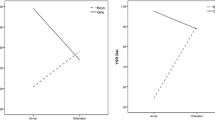Abstract
A sample of 100 incarcerated delinquent females and 100 nondelinquent female matched for age and socioeconomic status were compared on three aspects of sex-role identity. The Bem Sex-Role Inventory and the PRF ANDRO scale were used to assess sex-role androgyny; the Traditional Family Ideology scale was used to assess sex-role attitudes; and several questions concerning heterosexual relationships were asked. Correspondence between the two androgyny measures was moderate at the interval level of measurement and poor at the nominal level. Repeat offenders were significantly higher than first-time offenders and nondelinquents on the BSRI masculine scale; a significantly higher percentage of repeat offenders were classified as androgynous by the BSRI. No differences were observed using the PRF ANDRO scales. Heterosexual relationships were more important in the lives of delinquent females on both friendship and helping dimensions.
Similar content being viewed by others
References
Auricchio, E. W. A comparison of the sociological and psychological backgrounds of unwed mothers and aggressively delinquent girls at various ages. Dissertation Abstracts, 1972, 33(1-B), 434–435.
Bem, S. The measurement of psychological androgyny. Journal of Consulting and Clinical Psychology, 1974, 42, 155–162.
Bem, S. L. Beyond androgyny: Some presumptuous prescriptions for a liberated sexual identity. In J. A. Sherman & F. L. Denmark (Eds.), The psychology of women: Future directions in research. New York: Psychological Dimensions Inc., 1977. (a)
Bem, S. L. On the utility of alternative procedures for assessing psychological androgyny. Journal of Consulting and Clinical Psychology, 1977, 45, 195–205. (b)
Berzins, J. I., Welling, M. A., & Wetter, R. E. A measure of psychological androgyny derived from the Personality Research Form. Journal of Consulting and Clinial Psychology, 1978, 46, 126–138.
Cohen, J. A coefficient of agreement for nominal scales. Educational and Psychological Measurement, 1960, 20, 37–46.
Conger, J. J., & Miller, W. W. Personality, social class, and delinquency. New York: Wiley, 1966.
Constantinople, A. Masculinity-femininity: An exception to a famous dictum. Psychological Bulletin, 1973, 80, 389–407.
Deardorf, P. A., Finch, A. J., Jr., Kendall, P. C., Lira, F., & Indrisano, V. Empathy and socialization in repeat offenders, first offenders, and normals. Journal of Counseling Psychology, 1975, 22(5), 453–455.
Felsenburg, R. Special problems in treating female offenders: Unfeminine delinquent girls. International Journal of Offender Therapy, 1971, 15(1), 21–23.
Gaudreau, P. Factor analysis of the Bem Sex-Role Inventory. Journal of Consulting and Clinical Psychology, 1977, 25, 299–302.
Hetherington, E. M. Effects of father absence on personality development in adolescent daughters. Developmental Psychology, 1972, 7, 313–325.
Levinson, D., & Huffman, P. Traditional family ideology and its relation to personality. Journal of Personality, 1955, 23, 251–273.
Moore, R. J. Canadian adolescents and the challenge to demonstrate competence at personal physical risk. Adolescence, 1972, 7(26), 245–264.
Moran, P. A. The effect of father absence on delinquent males: Dependency and hypermasculinity. Dissertation Abstracts International, 1972, 33(3-B), 1292–1293.
Mortola, D. S. Aspects of the self-concept in delinquent girls: Maternal identification, sexual identification and body-concept. Dissertation Abstracts International, 1971, 31 (10-B), 6242–6243.
Muller, G. O., Shames, J., & Chazen, J. Delinquency and puberty: Examination of a juvenile delinquency fad. Criminal Law Education and Research Center, Monograph Series, 1971, 5.
Robinson, J. P., & Shaver, P. R. Measures of Social Psychological Attitudes. Ann Arbor, Michigan: Institute for Social Research, Univ. of Michigan, 1969.
Silverman, I. J. Compulsive masculinity and delinquency. Dissertation Abstracts International, 1970, 31(9-A), 4914–4915.
Author information
Authors and Affiliations
Rights and permissions
About this article
Cite this article
Edwards, K.J., Norcross, B.N. A comparison of two sex-role androgyny measures in a study of sex-role identity for incarcerated delinquent and nondelinquent females. Sex Roles 6, 859–870 (1980). https://doi.org/10.1007/BF00287240
Issue Date:
DOI: https://doi.org/10.1007/BF00287240




